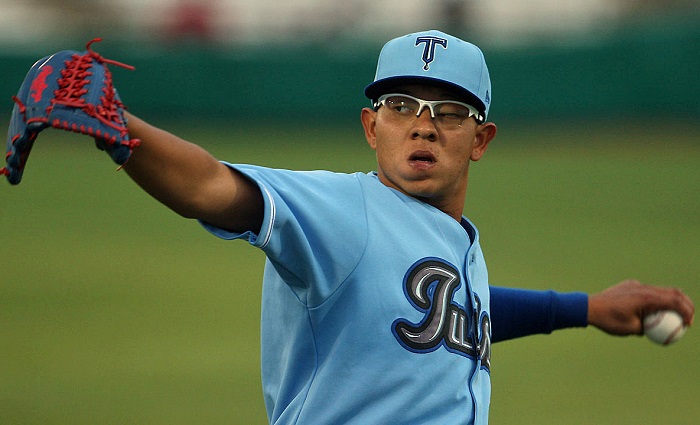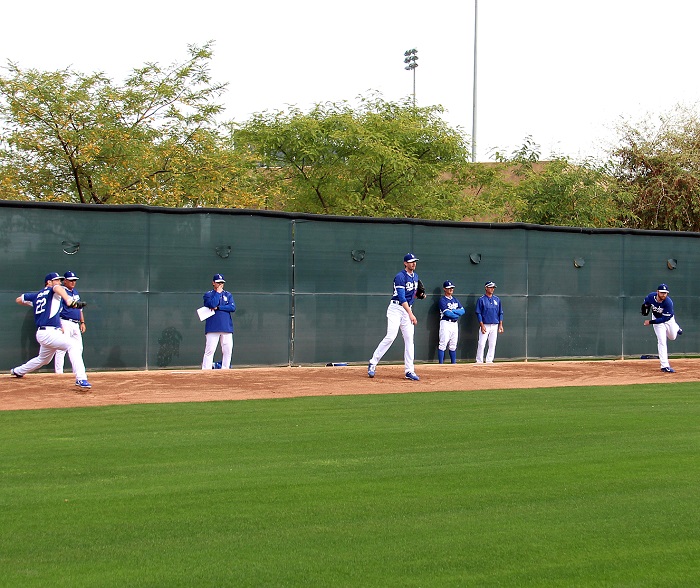Much talk is being bandied about regarding the Dodgers six starters that currently are on the roster. Many assume that the Dodgers’ stock-piling of starters is in preparation of a trade that will soon be made. I propose nothing of the sort.
It’s time for the Dodgers to consider instituting the “six-man” rotation.
It’s a new era in baseball. The days of starters pitching 250 innings and throwing 20 CGs a season are over. Nowadays, Tommy John surgery is the norm. Pitch counts are monitored by everyone and young up-and-coming pitchers are coddled and monitored to not overwork them. Think about it, in his three years in the minors, 19-year-old top pitching prospect Julio Urias has never pitched into the seventh inning of a game – not once. That’s something that never would have happened 30 years ago because there would be too many question marks about his durability.

Through three minor league seasons, Dodgers top pitching prospect Julio Urias has never pitched beyond the sixth inning. (Photo courtesy of MLB.com)
In today’s game, there are no Tom Lasorda’s out there that will pitch a guy like Fernando until his arm falls off. It makes perfect sense that teams protect their prized commodities by pitching them every sixth game instead of every fifth.
Advantages:
- The likes of Hyun-jin Ryu, Brett Anderson and Kenta Maeda will benefit. First because the longer workloads of five-man staffs have proved to be taxing on their arms as some return from injury or come from systems that already implement the six-man rotation, (Japan and Korea).
- Financially it’ll probably save the Dodgers on some contracts that kick in incentives for numbers of innings pitched.
- It allows for pitchers coming up from the minors to be gradually inserted into pitching staffs and not overworked, especially late in the year when such up-and-coming starters like Urias and Jose De Leon will be working in uncharted territory with regards to innings pitched.
Disadvantages:
- Clayton Kershaw could end up starting in about 10 fewer starts for the year.
- Adjustments for workhorse starters may be too difficult.
- You might not be able to easily adjust your rotation for important series to use your best starters in the series.
A six-man staff may be able to be juggled so that the ace goes every fifth day, which would probably be the perfect scenario for the Dodgers and Kershaw. It all depends on schedules and the flexibility of the other starters in the rotation. Do they have the ability to adjust to intermittent patterns? One week going on six days rest and then then next possibly on seven?

Could going to a six-man rotation add longevity to the Dodgers’ high-dollar rotation?
(Photo credit – Ron Cervenka)
Problems may arise in the fact that pitchers are creatures of habit and deviations from those habits often cause problems. Thus, the talents of manager Dave Roberts would truly be tested as he would be forced to somehow keep his six starters focused and in sync.
It’s a risk, I know that, but the additional rest and lesser workload would pay off in the dog days of summer IF the starters can adjust to the change. And change can happen. Think about the game 25-30 years ago when there was no such thing as a one-inning closer. La Russa introduced Dennis Eckersley to the role and the baseball world was changed forever. Now every team must have one.
It is only natural that the game evolves and lessens the workload of starting pitchers, simply because of the 25-million-dollar salaries that aces are now demanding. Teams must protect their prized commodities.




 January 7th, 2016 at 6:00 am
January 7th, 2016 at 6:00 am  by Evan Bladh
by Evan Bladh  Posted in
Posted in 

During the 2015 season, the Friedman/Zaidi-led Dodgers used a total of 16 different starting pitchers. And although only eight of the 16 made more than four starts, it clearly showed that F&Z had no qualms whatsoever about utilizing their entire 40-man roster to fulfill their wants and needs throughout the season. I certainly see no reason why they won’t do so again in 2016 and going forward. It is, by far, the most creative use of the entire 40-man roster I have ever witnessed, not just but the Dodgers but by any MLB team – and I applaud it.
Unlike years past, current Dodgers ownership see their Triple-A team (and even their Double-A team) as extensions of the 25-man active roster and not just a source of player development. They clearly have shown us that they are not afraid or intimidated by the 10-day waiting period to move players back and forth between Oklahona City (and Tulsa) and Los Angeles. By doing so, F&Z in essence, have a starting rotation that is basically limitless.
I like that aspect of F&Z too. That is, they build flexibility into everything they do. That is why it is important to get the payroll under control so they have flexibility in trades.
I guess the notion that you play your best players as often as possible is just old-fashioned, like needing speed at the top of the lineup. It worked for Alston and Lasorda. Most of the guys they brought up from Triple-A last year were a waste of a plane ticket.
I don’t see the six-man rotation catching on as long as starters are so expensive. I suppose if it meant the starters could go deeper into the game, a team without decent middle relief might try it. But do you really want five fewer starts from Kershaw? Last year Donnie gave his starters a lot of extra days off–I don’t know whether it helped, but it sure ticked off a lot of fans who’d bought tickets expecting to see Zack or Clayton pitch and ended up seeing an audition.
According to Baseball Reference, Maeda started 29 games last year, and there were “approximately” (?) 144 games played in Japan’s Central League. Now how could he start that many games in a six-man rotation?
The Nippon Professional Baseball League has no games scheduled on Mondays, so starters regularly are scheduled to go on five days rest. It is common practice in Japan and Korea and former Dodger pitchers Ishii, Ryu and Kuroda had some difficulties making the adjustment. Ishii was the one that had the most problems with the change.